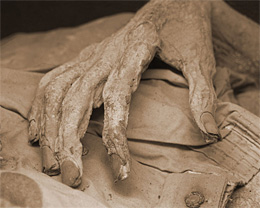 |
 |
 |
 News Around the Republic of Mexico | April 2007 News Around the Republic of Mexico | April 2007  
Scientists Prepare for Mummy Examinations
 Cindy Tumiel - San Antonio Express-News Cindy Tumiel - San Antonio Express-News


| | The remains were exhumed from graves or above-ground crypts between the late 1800s and 1950 because their families were poor and could not afford a local "burial tax" that paid for perpetual care. |
The dead don't give up their secrets easily — especially after decades in a crypt.

But a San Marcos forensic anthropologist is heading to Guanajuato, Mexico, next month with just such a mission in mind — pulling the scientific truth about life and death out of the mummified corpses that have become one of the city's most famed tourist attractions.

Jerry Melbye, a professor at Texas State University who is regularly consulted by police agencies for his expertise in identifying human remains, is part of a scientific team invited by the mayor of Guanajuato to explore the mysteries of some 100 naturally mummified corpses that have been on display in the city's Museo de las Momias since 1969.

The remains were exhumed from graves or above-ground crypts between the late 1800s and 1950 because their families were poor and could not afford a local "burial tax" that paid for perpetual care. Now housed in a museum, they have become a major tourist attraction.

Dr. Eduardo Romero Hicks, mayor of the colonial-style city in Mexico's mountainous interior, invited Melbye and two anthropologists from Quinnipiac University in Hamden, Conn., — Ronald Beckett and Gerald Conlogue — who examined some of the Guanajuato mummies five years ago.

The mayor asked the three scientists to apply their skills to see what forensic science can tell about the age, sex, race and cause of death of the rest of the mummies.

Most of what is known about the mummies' lives and deaths is just the subject of local lore. One was supposedly hanged by a brutal husband; another supposedly was buried alive.

"I would like to explore deeper into the origins and development of our mummies," Romero Hicks said in his invitation to Melbye.

The scientists will head south next month for a preliminary look at the project and expect to examine about 20 mummies, Beckett said. With those results, they will be able to seek more grant funds to complete the exams.

The Guanajuato mummies are likely the largest collection of naturally mummified humans in the Western hemisphere, Melbye and Beckett said. Part of the project is to understand how they turned into mummies.

"That is probably the easy part of the puzzle," Melbye said. "It almost always has to do with climate and soil conditions drying tissues out."

The high altitude, dry air and salty soil of the Mexican mountains probably are the cause, Melbye said. Under those conditions, skin and internal organs dehydrate and turn leathery.

ctumiel@express-news.net | 
 | |
 |



